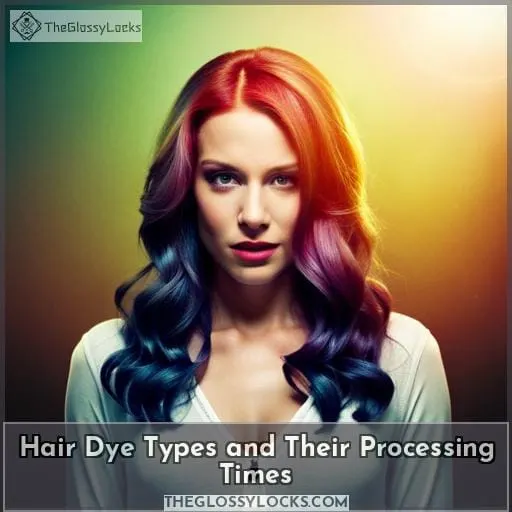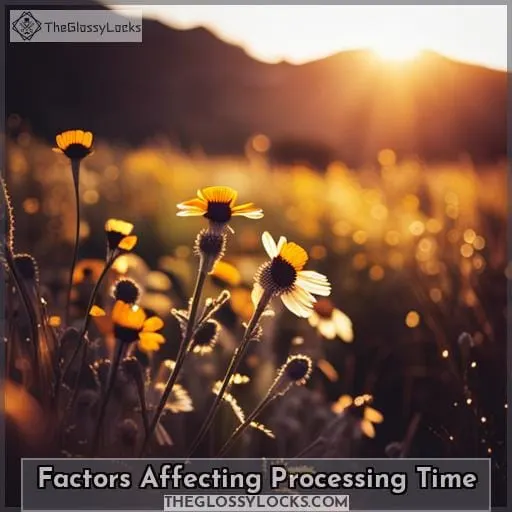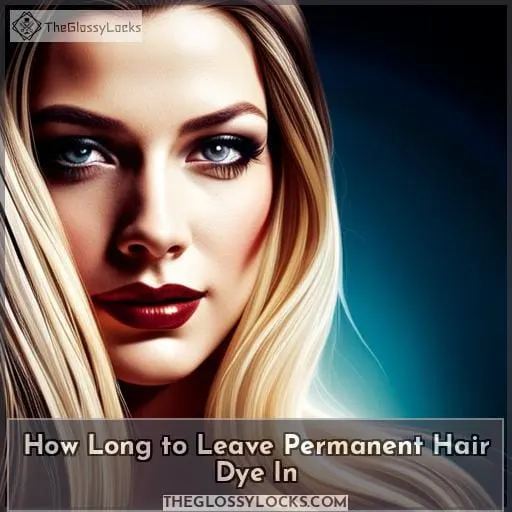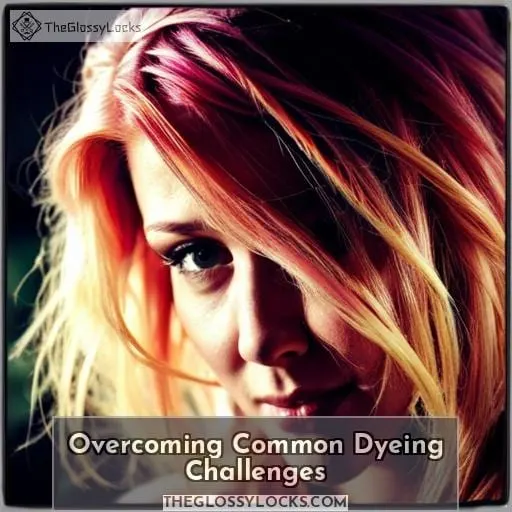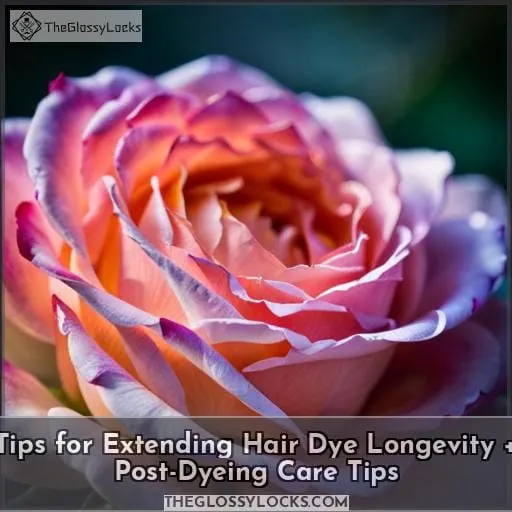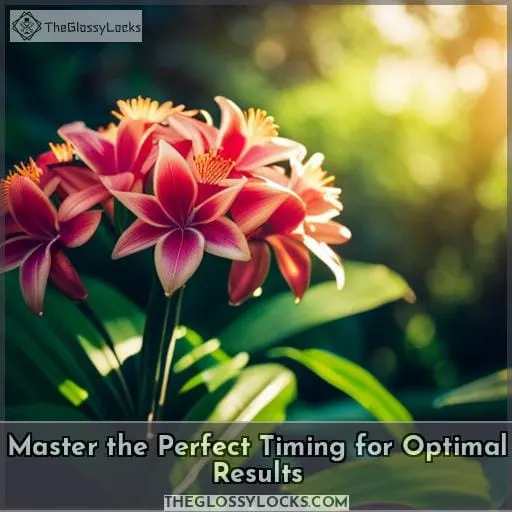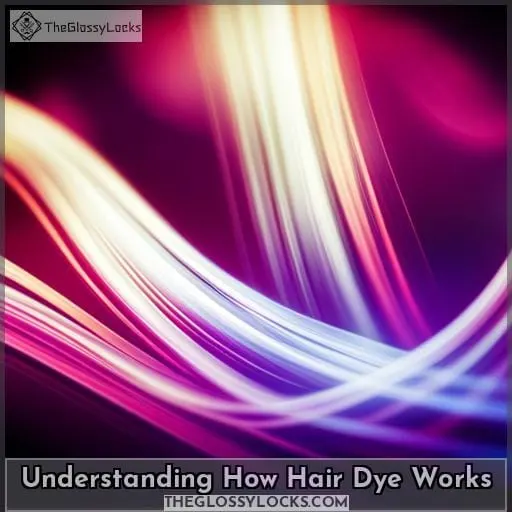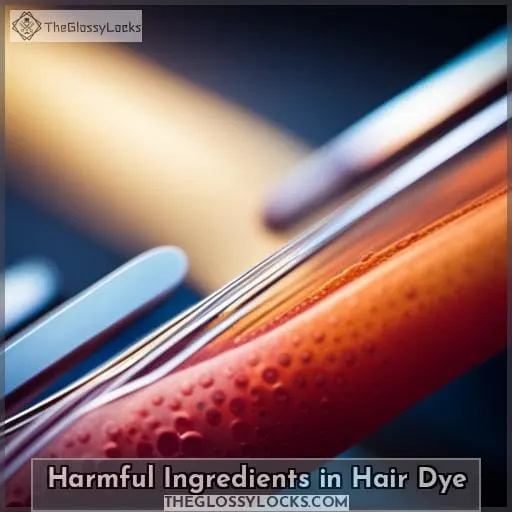This site is supported by our readers. We may earn a commission, at no cost to you, if you purchase through links.
 Achieve salon-quality color from the comfort of your home – it’s possible! In fact, 9 out of 10 Americans have colored their hair at least once.
Achieve salon-quality color from the comfort of your home – it’s possible! In fact, 9 out of 10 Americans have colored their hair at least once.
Knowing the answer to this will help ensure you get a vibrant and natural hue without any disasters along the way. We’ll explore what kind of dyes are best suited for different types and conditions of hair, factors that affect processing time, tips on extending dye longevity, as well as post-dye care advice.
This way, you can master perfect timing for optimal results with every application.
Table Of Contents
- Key Takeaways
- Hair Dye Types and Their Processing Times
- Factors Affecting Processing Time
- How Long to Leave Permanent Hair Dye In
- Overcoming Common Dyeing Challenges
- Tips for Extending Hair Dye Longevity + Post-Dyeing Care Tips
- Master the Perfect Timing for Optimal Results
- What to Do if You Leave Hair Dye in Too Long
- Understanding How Hair Dye Works
- Harmful Ingredients in Hair Dye
- Things to Consider When Choosing Hair Dye
- Conclusion
Key Takeaways
- Different types of hair dye have different recommended processing times, ranging from 15-25 minutes for demi-permanent dye to up to 8 weeks for semi-permanent dye.
- Factors such as hair type, condition, and developer strength can affect the processing time of hair dye.
- It is important to consider the formulation and brand of the hair dye when determining the processing time.
- Adjusting the processing time can help achieve the desired color intensity, and proper post-dyeing care can help extend the longevity of the hair color.
Hair Dye Types and Their Processing Times
Are you searching for the perfect hair dye to achieve your desired look? From demi-permanent and semi-permanent dyes to temporary and henna/plant-based coloring options, knowing how long each type of dye should be left in can help you achieve the best results.
Each type has its own unique processing time that varies depending on factors such as hair color, thickness, texture, and more.
Demi-Permanent Hair Dye
Demi-permanent hair dye typically requires 15-25 minutes of processing time for vibrant and lasting results. It offers advantages over permanent dyes, like reduced damage to the hair cuticle while still providing excellent gray coverage.
Application techniques are important for maximizing color payoff. Avoid washing the hair before use and thoroughly saturate each strand with product. Color fading can be prevented by avoiding heat styling products or other harsh chemicals, limiting shampooing frequency, and using gentle color-safe shampoos when needed.
Maintenance tips include choosing shades similar to natural tones and glosses for refreshing existing ones, as well as deep conditioning treatments at least once a week.
Semi-Permanent Hair Dye
Semi-permanent dyes offer an alternative for those looking to achieve vibrant and lasting color without the risk of damaging their hair.
Color refreshing techniques are available when fading occurs, but they must be done carefully to avoid over-processing or damage. Permanent dye is stronger than semi-permanent dye, which requires more time for optimal results.
However, this also means there’s a greater risk of causing damage if left on too long.
To maintain semi-permanent vibrancy longer, it is recommended to use shorter times when applying the dye and to avoid heat styling products afterwards, such as curling irons or blow dryers, which can cause further fading.
With proper care and following manufacturer instructions, you’ll get beautiful color results every time!
Temporary Hair Dye
Take your locks to the next level with a temporary hair dye – perfect for trying out new shades without committing! This type of dye is best suited for those who enjoy changing up their look on occasion, as it offers vibrant colors that are easy to remove.
Temporary dyes can be easily washed away and require minimal maintenance. However, they won’t last as long or cover gray hairs like semi-permanent dyes. They also lack conditioning benefits and may dry out strands if left in too long.
Consider all pros and cons before deciding which type of color is right for you. Then get ready to transform your tresses with beautiful, bold hues!
Henna and Plant-based Dyes
You’ll never guess how you can give your hair a unique look – with henna and plant-based dyes! Henna is an all-natural dye that’s been used for centuries to color hair, and it has some great benefits such as being long-lasting and conditioning.
Plant-based dyes are also gentler on the scalp than chemical-based products, leaving your locks softer while still giving them beautiful vibrant hues. To apply henna or other plant-based coloring agents correctly, ensure that you follow all instructions carefully when it comes to timing.
Leaving the dye in overnight or too long can result in damage or uneven coloration.
For best results, make sure to use developer strength according to product specifications so as not to harm your delicate strands – natural ingredients don’t necessarily mean gentle! With proper application of these nourishing colors, enjoy healthy-looking tresses full of life without sacrificing vibrancy!
Factors Affecting Processing Time
When it comes to how long you should leave dye in your hair, several factors play a role. These include the type and condition of your hair, as well as the strength of the developer used. Knowing these key points will help ensure that you achieve vibrant color results with minimal damage to your locks.
Hair Type and Condition
Your hair type and condition can significantly affect how long you should leave your dye in for optimal results. Highly porous hair may require less processing time, while gray coverage or thicker locks could need more.
Permanent dye needs 25-45 minutes, while semi-permanent requires 15-30 minutes. Overnight usage is generally not recommended due to potential damage caused by leaving it on too long.
For vibrant and healthy color maintenance over time, prioritize a regular conditioning routine with gentle products specifically designed for colored tresses. Also, limit heat styling to prevent fading or discoloration that can occur if left unchecked.
By understanding the nuances of each hair type’s unique requirements when coloring, as well as taking necessary precautions like patch tests prior to use, you’ll be sure to achieve beautiful results from every session!
Developer Strength
Be mindful of developer strength when dyeing your hair, as it can significantly impact the processing time and potential damage. For example, a stronger developer will require less time to process color than one with a lower percentage and vice versa.
Additionally, ammonia-free options are gentler on the hair but may take longer for desired results, while chemical-based products tend to work faster but risk more severe damage if left in too long.
Pay attention to these factors before applying any hair dye for optimal timing and color correction outcomes, while avoiding any unnecessary harm or disappointment from incorrect application techniques.
Dye Formulation and Brand
Explore the formulation and brand of your hair dye for its recommended processing time. Hair dye brands differ in their product effectiveness, user experiences, and even how often to color hair.
For damaged or porous hair needing moisture, a thick and coarse formula is best. Look into brands specifically formulated for gray coverage that won’t damage fragile strands; this will help you get vibrant results without overprocessing!
Consider the type of ingredients used as well. Many natural dyes are gentler than synthetic ones but may require more frequent applications to maintain color intensity.
Research various products online. Read reviews from trusted sources before making a decision on which one is right for you!
Coloring Technique
Applying your hair dye correctly is crucial to achieving the desired color results. For vibrant hues and blending grays, a patch test is essential before starting the process.
Preparing for dyeing involves understanding how formulations work with desired color intensity. Balayage or ombre techniques are often used in combination with permanent dyes. Professional stylists can help ensure even application of product as well as correct timing for optimal results.
They may also use heat styling to speed up the absorption rate of pigment into hair fibers during coloring processes such as highlights or lowlights.
Color correction requires specialized treatment and expertise for safety and effectiveness.
Desired Color Intensity
Determine the intensity of your desired color by considering processing time. Color dilution, dye fading, and pigment retention all come into play when controlling color intensity, making this a key factor in hair coloring success.
Depending on the type of dye used – permanent or semi-permanent – timing can range from 15 minutes to 45 minutes for maximum results.
Precolored hair may require less time than virgin hair, while gray hairs often take longer to process. Understanding how long you should leave permanent/semi-perm dyes on will help achieve the desired hue and maintain vibrant locks with proper care.
To do this, limit washing frequency, avoid heat styling and harsh chemicals, use a color-safe shampoo and conditioner, protect from UV rays, deep condition regularly, and refresh colors using glosses.
How Long to Leave Permanent Hair Dye In
If you’re considering dyeing your hair, timing is key. For dark virgin hair, permanent dye should be left in for 25-45 minutes; pre-colored hair may require slightly longer processing time of 30-50 minutes; resistant gray hairs will need up to an hour of exposure to the colorant; touching up roots generally takes about 20-30 minutes per application while fashion colors or pastel shades can take anywhere from 15-25 minutes.
For Dark, Virgin Hair
For dark, virgin hair, you should leave permanent dye in for about 25-45 minutes to achieve the desired color results. Hair porosity and texture can impact processing time. It is important to prevent damage when using permanent dye.
Washing your hair before applying semi-permanent dye is optional, but it is still recommended to patch test and ensure even application. Timing becomes crucial when dealing with damaged or porous hair. Afterward, use gentle products such as sulfate-free conditioners and limit heat styling sessions to maintain vibrant colors over time.
For Precolored Hair
Before applying permanent dye to precolored hair, bear in mind that you may need to leave it in for longer than usual. Dyeing techniques, such as color correction and gray hair coverage, require more time when dealing with pre-colored strands.
Additionally, shampoo before dyeing and follow post-dyeing care tips. These include avoiding chlorine and saltwater, protecting your tresses from UV rays with a hat or scarf, and deep conditioning regularly.
For Resistant Gray Hair
You won’t believe how long it’ll take to get that gray hair looking fresh – no matter how resistant it is! Processing times for permanent dye on resistant gray hair can range from 25-45 minutes. Hair porosity and color correction techniques also play a role in the time needed to achieve desired results.
Consider seeking professional help if you’re having trouble maintaining your hair dye or dealing with common dyeing challenges like even application and adjusting intensity. Refresh your color with glosses, use gentle products, reduce washing frequency, and avoid excessive heat styling.
For Touching-Up Roots
If you want to touch up your roots, permanent hair dye can help achieve a vibrant and long-lasting color that complements the rest of your look.
- Make sure to choose a root touch-up product specifically designed for gray hair.
- Use color-safe products after coloring.
- Avoid sulfates in shampoos and conditioners as they strip away dye.
- Select the right shade before application for best results.
When performing an at-home root touch-up, consider factors such as expertise, application technique, timing, and product selection.
For Fashion Colors or Pastel Shades
For fashion colors or pastel shades, take a dip into the beauty pool and let your hair soak up the color like an eager sponge. Prepare for dyeing with care: clean and dry hair, patch test, and seek professional advice.
Timing is crucial. Permanent dye should be left on for 25-45 minutes, while semi-permanent dye requires 15-30 minutes. To avoid damage from heat styling and over-washing, use gentle products specifically designed for colored hair protection.
Maximize your results by understanding the type of dye you’re using and its ingredients. This will help you achieve the desired intensity without causing harm to your locks.
Overcoming Common Dyeing Challenges
When dyeing hair, achieving even color application, adjusting intensity with dilution, and conquering resistant gray hair can be difficult tasks. Dealing with previously dyed or highlighted strands requires special attention too.
Ensure Even Color Application
To ensure even color application, apply the dye with an even pressure and avoid overlapping sections. Dilution techniques can be used to cover resistant gray hair or previous dye challenges. Hair dye longevity is impacted by factors such as heat styling; using it sparingly will increase color vibrancy and longevity.
To master perfect timing for optimal results, consult professional stylists for advice on choosing the right shade. Follow specific product instructions regarding processing time. Use gentle products that are designed for colored hair.
Take into account all these details to create a beautiful look while protecting your locks from damage!
Adjusting Intensity With Dilution
You can adjust the intensity of your dye by diluting it with a lighter shade, creating a unique look that’s sure to turn heads! Try mixing some conditioner into your dye for subtle color adjustments.
For more dramatic changes, mix in a different color or tonal shade and experiment until you’re satisfied with the results. If you want to lighten up dark hair colors without using bleach, try adding clear or silver toners as they will help neutralize strong pigments.
Other dilution techniques include applying water directly onto hair before coloring or pre-mixing a small amount of dye solution in warm water first before spreading it on strands evenly.
Conquering Resistant Gray Hair
Conquer resistant gray hair with the right dye duration for an unbeatably vibrant, even color! Know your options: permanent and semi-permanent dyes, developers of different strengths. Time it perfectly to achieve desired results – 25-45 minutes for permanent dye; 15-30 minutes for semi-permanent.
Gray hair does require longer processing times than other colors due to its unique properties. Avoid leaving it in too long as this can lead to dryness and breakage. Stick strictly within the time frames given by product instructions or a professional hairdresser’s advice.
Keep gray hair healthy with protective products specifically designed for colored tresses without harsh chemicals like sulfates or ammonia.
Transform grey locks into your desired hue today – great things come from careful timing!
Dealing With Previous Dye or Highlights
When dealing with previous dye or highlights, it is important to understand how much time is necessary for each step of the process in order to achieve the desired results. For example, applying a semi-permanent color over an existing permanent hair color can require more processing time than usual.
To transition between colors without damaging your hair, consider using toning tips to fade highlights and manage regrowth while avoiding harsh chemicals like hydrogen peroxide during the color correction process.
Utilizing these methods will help you safely find the right balance for transitioning from one hue to another without causing any damage.
Tips for Extending Hair Dye Longevity + Post-Dyeing Care Tips
To ensure your hair dye lasts longer and looks vibrant, it is important to wash with cool water and limit the frequency of washing. This will help preserve the color intensity of your dyed locks while also minimizing potential damage.
Wash With Cool Water
Cool down after dyeing to protect your locks from damage and extend the life of your hair color! Washing hair with cool water preserves vibrant dye and avoids fading by minimizing cuticle opening and color molecule escape.
Lower temperature rinses also hydrate strands, reducing brittle dryness from dye chemicals. This post-dyeing care tip maintains the integrity of color, keeps hair healthy, and benefits color longevity.
Limit Washing Frequency
To maintain vibrant color, limit the frequency of washing your hair to preserve dye longevity. Try shampoo alternatives such as co-washing and cleansing conditioners. Use cold water when rinsing dyed hair – hot water opens up the cuticles, which can strip off more color than necessary.
Invest in quality products specifically designed for colored hair to reduce fading. Use UV protection sprays and oils before exposing your locks to sun rays or chlorine from swimming pools.
Avoid Sulfates and Harsh Chemicals
Forego harsh shampoos with sulfates that will strip your color, babe. For optimal hair health and long-lasting dye vibrancy, switch to gentle cleansing methods and chemical-free products like those made from natural oils or plant extracts.
Try adding a sulfate-free alternative into your hair care routine for vibrant locks! Healthy hair maintenance requires more than just avoiding wash day too often; use nourishing masks regularly to promote hydrated strands post-dyeing sesh.
Protect Hair From UV Rays
Protect your tresses from UV exposure by wearing a hat or using sunscreen products specifically designed for hair. To prevent damage, make sure you take the necessary precautions when exposing your hair to sunlight.
- Use a broad-spectrum sunscreen product with an SPF of 15 or higher on exposed areas of the scalp and strands.
- Before going outdoors, spray on protective oils that shield against harmful rays like avocado oil and coconut oil.
- Wear hats as they provide excellent sun protection. They still allow air flow around the head to keep it cool in hot weather conditions.
- Avoid leaving dye in too long as this can cause further damage due to prolonged exposure under direct sunlight’s strong ultraviolet radiation (UV).
Properly protecting your colored locks will help maintain vibrant color over time while avoiding discoloration caused by sunburns or heat styling tools.
Master the Perfect Timing for Optimal Results
Mastering the perfect timing for optimal results is key to achieving your desired hair color, so take extra care with each step of your dyeing process!
Timing tips include understanding dye types and ingredients. Consider factors like hair porosity, shade selection, and patch tests. Conduct strand tests prior to usage. Leave permanent dyes in for 25-45 minutes or semi-permanent ones up to an hour.
Color intensity also affects processing precision. Dark virgin hair needs more time than precolored or gray resistant locks. Optimal duration varies based on brand instructions, but generally avoid overnight applications.
Lastly, mastering dyeing requires patience and practice. Use gentle products for colored tresses while avoiding excessive heat styling between coloring sessions.
What to Do if You Leave Hair Dye in Too Long
If you’ve left your hair dye in too long, taking quick action can help remedy the situation. To avoid damaging your hair any further, stop all chemical processing and use a color-safe shampoo and conditioner to get rid of excess dye.
If possible, re-dyeing with a lighter shade is an effective way to fix over processed hair. In some cases, it might be necessary to seek professional help for more extreme color corrections or if you are dealing with damaged locks due to prolonged exposure from the chemicals used in dyes.
For those suffering from repeated mistakes while trying different shades of colors at home, look into semi-permanent products that provide better control as they don’t contain ammonia or peroxide, which can damage delicate strands when applied too often or left on for extended periods of time!
Additionally, using special treatments such as glosses may also be beneficial in refreshing dull hues without having to go through another round of the coloring process entirely – giving tired tresses much-needed TLC after experiencing multiple dyeing disasters!
Understanding How Hair Dye Works
Understanding how hair dye works is essential for achieving the desired results. Non-permanent dyes are a great option for those looking to experiment with color without committing, while permanent dyes provide long-lasting and vibrant colors.
With knowledge of the different types of hair dye available and appropriate processing times, you can attain beautiful colored locks that last.
Non-Permanent Hair Dye
Take control of your locks with non-permanent hair dye, offering vibrant color without intense commitment. Temporary dyes provide a quick and easy way to experiment with different shades, from subtle highlights to bold pastels.
Henna is also an option for gray coverage; however, its long processing time requires patience and precision when handling developer strength.
Permanent Hair Dye
For permanent hair dye, it’s important to consider factors such as the shade you’re looking for and your hair type when determining how long you should leave the color in. Permanent dye usually requires 25-45 minutes of processing time depending on porosity and gray coverage needs.
Color correction can be done with a professional-grade remover kit containing argan oil, though this may cause some damage due to its strength. When using permanent dyes, make sure they are evenly applied over all strands of hair for best results.
Avoid leaving them in too long or heat styling afterward, as this could result in dryness or breakage.
Follow manufacturer instructions and keep an eye on timing for optimal vibrant color!
Harmful Ingredients in Hair Dye
Hair dyeing can be damaging to your hair if you do not know which ingredients to look out for. Two of the most commonly used and potentially harmful chemicals in hair dyes are ammonia and Para-Phenylenediamine (PPD).
Knowing how long you should leave these types of dyes in your hair is key to keeping it healthy while achieving vibrant color results.
Ammonia
Feel the power of hair transformation – without risking damage – by understanding that ammonia is a key ingredient in permanent dyes and should be used cautiously. Ammonia can cause scalp sensitivity, allergic reactions, and reduce dye longevity.
Instead of relying on ammonia-based products for coloring your hair, opt for alternatives like color stripping or semi-permanent dyes to avoid potential harm. Take extra caution when applying intense colors as they may contain more aggressive ingredients than lighter shades.
Research product labels carefully to ensure you’re aware of all contents before use; note any warnings regarding skin contact or inhalation during application too! Seek professional advice if needed as you strive towards beautiful locks with minimal risk involved.
Para-Phenylenediamine (PPD)
Be mindful of the harmful ingredient PPD, which is present in some hair dyes and can cause skin irritations when not used properly. Many people are allergic to this chemical, so it’s essential to do a patch test before applying dye containing PPD.
If an allergy occurs, there are many alternatives available that use natural ingredients or are completely free from chemicals like ammonia and peroxide. To stay safe while using hair dye products with PPD, always wear gloves and follow instructions carefully.
Keeping color on for too long can lead to health risks such as respiratory problems or a burning sensation in the eyes, throat, or skin.
For those looking for safer options during coloring their hair, check out products labeled ‘PPD-free’ or consider henna-based colors instead!
Titanium Dioxide
Take heed of titanium dioxide in hair dye – it can wreak havoc on your strands like nothing else! Found as an ingredient in many dyes, this chemical may cause damage to the skin and lungs when inhaled through the fumes.
Titanium dioxide is also a common component of many cosmetics and sunscreens due to its ability to reflect UV rays. However, its use has raised health concerns over potential carcinogenic effects.
If you’re looking for safe alternatives, opt for natural dyes that contain no harsh chemicals or irritants such as henna or ammonia-free semi-permanent colors.
Resorcinol
You should be aware of the presence of resorcinol in some hair dyes, as it can cause irritation and prolonged exposure may be hazardous.
- Resorcinol safety: Prolonged exposure to high concentrations can lead to adverse health effects such as skin rash or eye irritation.
- Resorcinol alternatives: Look for hair dye products that contain less toxic ingredients like hydrogen peroxide and ethanolamine instead of resorcinol if possible, particularly if you have sensitive skin or allergies.
- Resorcinol in cosmetics: It is important to read labels carefully when selecting a product because not all brands disclose the presence of this potentially harmful ingredient on their packaging, even though it is commonly used in many types of products including shampoos, lotions, creams, etc.
- Resorcinol in Hair Dye: This chemical should only be used occasionally for coloring grey hairs since there are safer alternatives available today that do not pose any significant risk with regular use over time.
- Resorcinol Health Concerns: Long-term use could eventually result in dangerous side effects, so it’s best avoided altogether unless absolutely necessary due to the potential risks associated with repeated contact with your scalp.
Things to Consider When Choosing Hair Dye
When it comes to hair dye, there are several factors that you should consider. Hair porosity and dye duration must be taken into account when determining how long the product should stay in; gray hair may require longer processing times while permanent dyes usually need between 30-45 minutes.
Semi-permanent colors can often remain on for up to an hour. It is important to follow specific product instructions for recommended application times in order to achieve vibrant and long-lasting color results with minimal damage or unevenness over time.
Hair porosity and dye duration
Embark on a journey of discovery and explore how your hair’s porosity can affect the time you spend in vibrant, glossy color.
Highly porous hair requires less dye duration than low porosity strands. Gray locks may need extra minutes for an even hue coverage.
Be mindful of brand instructions or consult a professional stylist if unsure about which is right for you.
Gray hair processing times
To achieve the most vibrant color, be aware that gray hair typically requires longer processing times for dye. When dealing with coloring resistant gray, consider factors such as developer strength and the type of dye used.
To manage your roots well, use a semi-permanent or demi-permanent hair dye and avoid intense heat styling.
Gray hairs need special care when it comes to maintenance. It is recommended to use products specifically designed for dyed tresses in order to protect them from UV rays.
Recommended dyeing times
Follow product instructions carefully to ensure the right dyeing time for your hair. Permanent dye should be left in for at least 30-45 minutes, while semi-permanent typically requires 15-30 minutes.
Don’t leave permanent dye on too long or it can lead to dryness and breakage. Leaving semi-permanent in longer could result in a darker shade than desired. To maintain vibrant color over time, avoid heat styling and use gentle products tailored toward colored locks.
Take these precautions when considering how long you should leave hair dye in for optimal results that last!
Conclusion
Using hair dye to achieve the look you want can be a tricky task. To make sure you get the desired results, it’s important to understand how long to leave hair dye in and the different ingredients used in hair dye.
According to studies, the average person spends over $400 a year on hair dye, and it’s essential to know the various types of hair dye and their processing times to avoid any damage or color missteps.
For permanent dyes, dark and virgin hair should be left in for 25-45 minutes, precolored hair for up to 25 minutes, resistant gray hair for 45 minutes, and touching up roots for 20-30 minutes. Factors like hair type, texture, and health also play a role in the processing time.
When it comes to post-dyeing care, use color-safe products, wash with cool water, limit washing frequency, avoid sulfates and harsh chemicals, and protect hair from UV rays. By understanding the different types of hair dye and knowing how long to leave them in, you can avoid any damage and get the look you desire.

